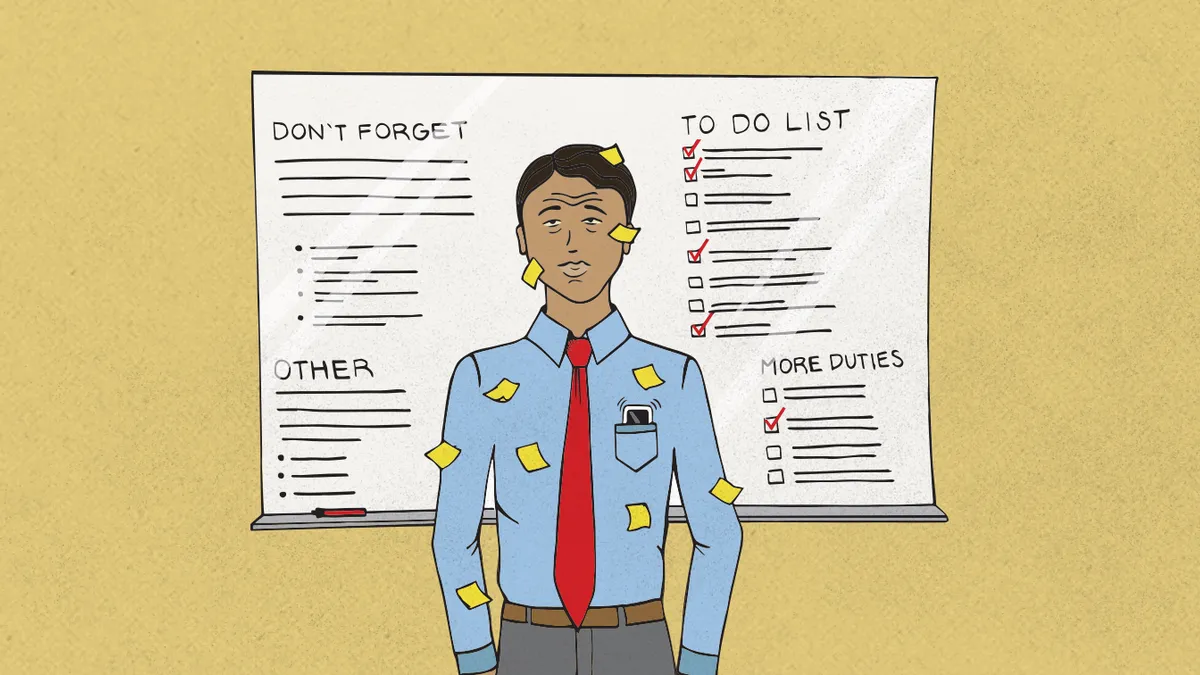In "Other Duties as Assigned," HR Dive editor Kate Tornone weighs in on employment trends, compliance best practices and, of course, the situations that require you to go above and beyond your normal duties. Today: understanding the FMLA's notice timeline, and why it's so important.
While some federal agencies leave you to design your own forms — sorry, there’s still no Americans with Disabilities Act (ADA) "accommodation form" — the U.S. Department of Labor has you covered when it comes to the Family and Medical Leave Act (FMLA).
And while use of DOL’s forms is optional in some cases, much of the information contained in the forms must be provided if you design your own. This means that many HR professionals like relying on them, and most seem to have little trouble using them. Instead, it’s timing and communication issues that seem to result in horror stories, both those I’ve heard personally and those we see in fact patterns in court opinions, like the company that will face a jury trial in the next few weeks because it fired an employee after confusion about how much leave she had available. Yikes.
So many interference claims can be avoided with a good understanding of your notice responsibilities, clear communication and training. This means that your “other duty” today is to make sure everyone involved in leave administration at your organization, especially front-line managers, has those three items covered.
Notice rights and responsibilities
Understanding your notice rights and responsibilities may not be the most exciting piece of this puzzle, but it's the low-hanging fruit. DOL has very rigid requirements for FMLA notices and if you can figuratively check all of those boxes, you're a third of the way there. In fact, when you’re done reading, I’ll reward you with a checklist that you can bookmark or save or print on t-shirts for your managers so you can literally check those boxes.
General notice requirements
First, if you’re a covered employer, you need to display a general notice (WH-1420) and also provide an individual notice to each employee. These mandates have quite a few sub-requirements, so make sure you read up on them on DOL’s website. (Not sure if you’re a covered employer? Here you go.)
Eligibility, certification and rights and responsibilities
Once you're on notice that someone needs time off from work for a reason that might be covered by the FMLA, the clock starts ticking. You have five days to get them an eligibility determination, which addresses whether they're even a candidate for leave, and a notice of their rights and responsibilities. Form WH-381 will satisfy both of those requirements.
If you want certification of the need for leave (permitted under certain circumstances), this is also the time to ask for it. DOL has forms for every kind of certification you might need on its website. You can generally require that the employee have this form back to you within 15 days. (Rules about who pays and how many chances the employee gets are spelled out here.)
Once the certification comes in, you’ll have to decide whether it demonstrates FMLA eligibility. If it does, congrats! Jump ahead to “designation notice.” If the certification is incomplete or insufficient, you have to explain why (requirements here) and the employee generally has seven days to try again.
Designation notice
Next up is the “designation notice,” which DOL’s Form WH-382 will satisfy. This tells the employee whether his or her requested leave will be designated as FMLA leave and generally needs to be provided within five days of you receiving complete and sufficient certification.
Also, if you’re going to require an employee to undergo a fitness-for-duty exam at the end of their leave (requirements are here), you have to let them know at this stage.
Recertification
Once an employee goes out on leave, your work is hardly finished. Workers frequently ask to extend their leave; sometimes you can request recertification, but there are limits, especially if you’re dealing with intermittent leave. The same goes for repeated fitness-for-duty exams. Details are in DOL’s respective fact sheets.
When done properly, however, recertification can be a great way to combat abuse if the FMLA flu seems to be going around your workforce — but that’s a topic for another day.
Return to work
OK, now you’re almost done with the paperwork. When an employee’s leave is ending, you can require a fitness-for-duty exam, if you told them you’d need this at the designation stage, as mentioned above. But as with everything else, there are other limits. Mostly, it needs to be relevant to their leave and job. And you might want to borrow that Genetic Information Nondiscrimination Act language from Section III of WH-380-E.
Bonus points: Whether or not you’re going to require a fitness-for-duty exam, experts say it makes sense to send employees a notice that says their leave is wrapping up, that you’re super excited to see them again, and that if they need anything, to please let you know. This sets them up to request a workplace accommodation, including a leave extension. (I realize that sounds like something you might not want to invite, but if you know or should know that someone needs a disability accommodation, the employer can be held liable for failing to offer it. Like the FMLA, workers don’t even need to know the ADA exists to be protected by it.)
Training and communication
Whether or not you manage this process on your own or outsource it, training and communication are key. I know you have to back-burner a lot of things, but FMLA requests can’t be one of them, which means that you need to understand your responsibilities before a request comes in. You can't ignore an employee's request just because you're not sure what the next step is. (Yes, that happened.)
It's true that sometimes courts will let a technical violation slide if an employee still received everything to which he or she was entitled (namely, leave and job restoration), but that won't help you if your front-line managers are out there telling people "we don't do FMLA." (Yes, that happened, too. Try not to let that one keep you up tonight.)
In fact, officials from the agencies that enforce employment laws regularly say that front-line managers cause most violations. Just as you need to train managers on identifying harassment, concerted activity and accommodation requests, you need to train them on identifying and escalating a request for FMLA leave. One misstep can amount to inference with an employee’s rights, which can result in not only significant liability for the employer, but individual liability for you. (Ok, if that one doesn't have you tossing and turning later then I can't help you.)
Finally, there are so many other factors we haven’t discussed here — foreseeable versus unforeseeable leave, multilingual workforces or your ability to contact employees’ healthcare providers, for example — and each situation is different, so you’ll have to make sure you’ve done your homework (or hired an attorney to do your homework for you) before you get involved some of the more complicated tasks.
Ok, you’ve earned it. Without further ado, your FMLA notice checklist:
FMLA notice checklist
- You post WH-1420 and provide individual notices.
- Employee puts you on notice of need for leave.
- Within five days, you provide WH-381 and, if desired, the relevant certification form (WH-380-E, WH-380-F, WH-384, WH-385 or WH-385V).
-
Within 15 days (assuming there are no extenuating circumstances), the employee returns the relevant certification form.
- If incomplete/insufficient, you explain what's missing.
- Within seven days (under most circumstances), employee submits complete/sufficient certification.
- Within five days, you provide WH-382 and, if desired, a fitness-for-duty notice.
- When the leave nears its end, you get in touch about the fitness-for-duty exam and, as a best practice, provide a notice that the leave is coming to an end and an invitation to contact you if assistance is needed.




















